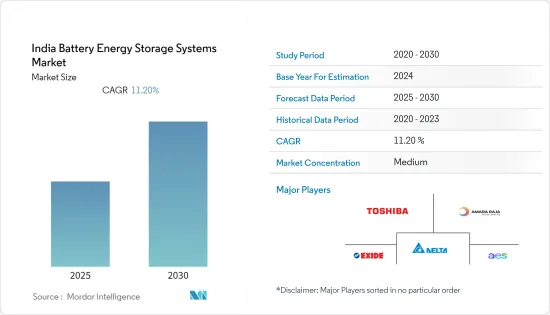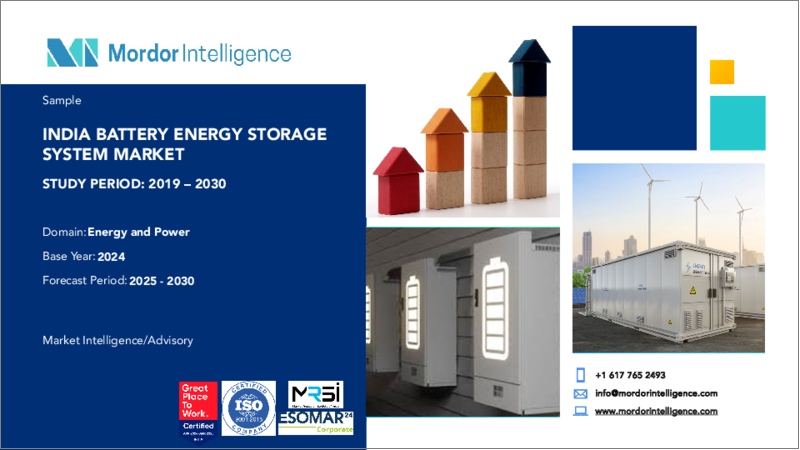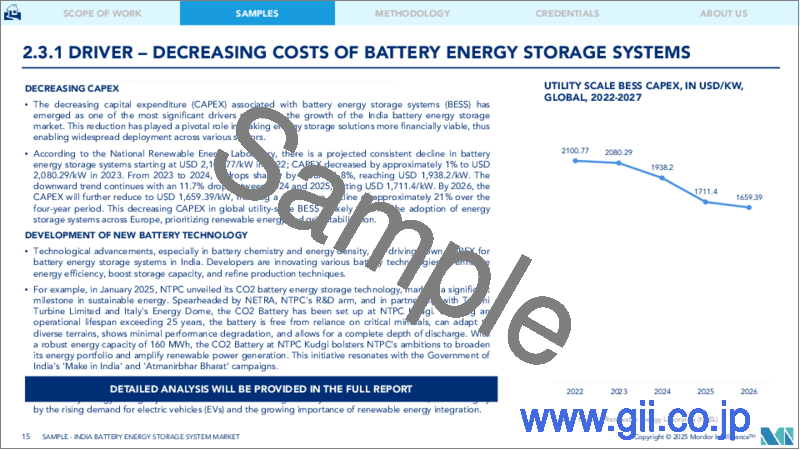|
|
市場調査レポート
商品コード
1643175
インドのバッテリーエネルギー貯蔵システム-市場シェア分析、産業動向と統計、成長予測(2025年~2030年)India Battery Energy Storage Systems - Market Share Analysis, Industry Trends & Statistics, Growth Forecasts (2025 - 2030) |
||||||
カスタマイズ可能
適宜更新あり
|
|||||||
価格
| インドのバッテリーエネルギー貯蔵システム-市場シェア分析、産業動向と統計、成長予測(2025年~2030年) |
|
出版日: 2025年01月05日
発行: Mordor Intelligence
ページ情報: 英文 95 Pages
納期: 2~3営業日
|
全表示
- 概要
- 目次
概要
インドのバッテリーエネルギー貯蔵システム(BESS)市場は予測期間中にCAGR 11.2%を記録する見込み

主要ハイライト
- 中期的には、リチウムイオン電池の価格下落やエネルギー貯蔵の導入を促進する政府の取り組みなどの要因が、予測期間中のインド電池エネルギー貯蔵システム市場を牽引するとみられます。
- その一方で、エネルギー貯蔵の運用と所有に関する規則が不透明であることが、調査期間中のインド電池エネルギー貯蔵システム(BESS)市場の成長を妨げる可能性が高いです。
- エネルギーを貯蔵するための新しいバッテリー技術の技術的進歩や、2030年までに再生可能エネルギー容量を約500GWに到達させるというインドの目標は、予測期間中にインドのBESS市場に有利な成長機会を生み出す可能性が高いです。
インドの蓄電池市場動向
リチウムイオン電池セグメントが市場を独占する見込み
- リチウムイオン電池は再生可能エネルギー発電プロジェクトで高い需要があります。多くの再生可能エネルギー産業の専門家は、インドにおける再生可能エネルギーの成長はエネルギー貯蔵システムなしでは不完全であり、リチウム電池は最も費用対効果の高い統合を提供すると考えています。
- リチウム太陽電池は再充電可能なエネルギー貯蔵ソリューションであり、太陽光発電システムと組み合わせて余剰の太陽光電力を貯蔵することができます。インドの太陽光発電設備容量は、2022年11月30日現在で約6,197万kWであり、政府は2022年までにその割合を1億kWに増やすという野心的な目標を達成するため、多くのプロジェクトを計画しました。しかし、太陽光発電の供給は断続的であるため、多くの民間企業が太陽光発電+エネルギー貯蔵プロジェクトを計画し、送電網への継続的な電力供給を確保しています。
- 2023年6月、Tata Groupの子会社であるAgratas Energy Storage Solutions Private Limitedは、グジャラート州にインド初のリチウムイオン電池のギガ工場を設立する契約をグジャラート州政府と締結しました。同社は、20ギガワット(GW)ユニットを設立するため、当初15億7,000万米ドルを投資する予定です。
- Tata Power Solar Systems Limited(Tata Power Solar)は、チャティスガル州でSolar Energy Corporation of India Ltd(SECI)から太陽光+蓄電プロジェクトを受注しました。このプロジェクトには、容量120MWhの実用規模のバッテリーエネルギー貯蔵システム(BESS)を備えた100MWの太陽光発電所のEPCサービスが含まれます。プロジェクトの総支出額は約1億1,500万米ドル。2023年後半に試運転が開始される予定です。
- さらに、電池エネルギー貯蔵システムと統合されたラマギリ太陽風力ハイブリッドプロジェクトは、インドにおけるエネルギー貯蔵開発の完璧な例です。アンドラ・プラデシュ州アナンタプルに位置するこのプロジェクトは、Solar Energy Corporation of India(SECI)が所有しています。現在建設中で、2022年までに完成する予定です。
- こうした新興国市場の開拓により、予測期間中はリチウムイオン電池セグメントが最大の市場シェアを占めると予想されます。
政府の取り組みが市場を牽引
- インドのバッテリーエネルギー貯蔵市場は、技術導入を容易にするための政府の支援施策やイニシアティブによってさらに牽引される可能性が高いです。
- インドの電力容量の増加は、インド政府の期待通りではありません。そのため、政府はさまざまな火力発電や再生可能エネルギープロジェクトを含めることで、このセグメントを後押ししようとしています。再生可能エネルギーの設備容量(大規模水力発電を含む)は、2014年3月の76.37GWから2022年12月には167.75GWに増加しました。
- 中央電力局によると、2022~23年の再生可能エネルギー発電量は2,035億5,200万個(MU)で、前年度比年率19%増です。
- 総再生可能エネルギー設備容量のうち、インドのバッテリー蓄電設備容量は2021年時点で約20MWであり、2030年までに必要な容量は約38GWになると推定されています。インド政府や関連団体により、再生可能エネルギー発電プロジェクトに蓄電システムを統合するプロジェクトがいくつか計画されています。
- 2022年10月、米国エネルギー省(DOE)とインド電力省(MoP)は、エネルギー貯蔵タスクフォースを設立し、クリーンエネルギーの未来への移行を促進するため、エネルギー貯蔵技術の規模拡大と展開の加速化を支援するため、両国の政府高官、産業代表、その他の利害関係者間の継続的で有意義な対話を促進しています。
- こうした開発により、予測期間中、政府施策が最も重要な市場促進要因になると予想されます。
インドのバッテリーエネルギー貯蔵システム産業概要
インドのバッテリーエネルギー貯蔵システム市場は適度にセグメント化されています。同市場の主要企業(順不同)には、Toshiba Corporation、AES Corporation、Exide Industries Ltd、Delta Electronics Inc.、Amara Raja Groupなどがあります。
その他の特典
- エクセル形式の市場予測(ME)シート
- 3ヶ月間のアナリストサポート
目次
第1章 イントロダクション
- 調査範囲
- 市場の定義
- 調査の前提
第2章 エグゼクティブサマリー
第3章 調査手法
第4章 市場概要
- イントロダクション
- 2028年までの市場規模と需要予測(単位:米ドル)
- 最近の動向と開発
- 政府の規制と施策
- 市場力学
- 促進要因
- エネルギー貯蔵技術のコスト低下
- エネルギー貯蔵の普及を促進する政府の取り組み
- 抑制要因
- エネルギー貯蔵の運用と所有に関する規則の不確実性
- 促進要因
- サプライチェーン分析
- PESTLE分析
第5章 市場セグメンテーション
- 電池タイプ
- リチウムイオン
- 鉛蓄電池
- フロー
- その他
- 接続タイプ
- オングリッド
- オフグリッド
第6章 競合情勢
- M&A、合弁事業、提携、協定
- 主要企業の戦略
- 企業プロファイル
- AES Corporation
- Exide Industries Ltd.
- Delta Electronics Inc.
- Toshiba Corporation
- Amara Raja Group
- Panasonic Corporation
第7章 市場機会と今後の動向
- 2030年までに約500GWの再生可能エネルギー容量を達成するというインドの目標
目次
Product Code: 70157
The India Battery Energy Storage Systems Market is expected to register a CAGR of 11.2% during the forecast period.

Key Highlights
- Over the medium term, factors such as declining prices of lithium-ion batteries and government initiatives to promote energy storage deployment are likely to drive the India battery energy storage systems market in the forecast period.
- On the other hand, the uncertainty in the rules governing energy storage operations and ownership will likely hinder the growth of the India battery energy storage systems (BESS) market in the studied period.
- Nevertheless, technological advancements in new battery technologies to store energy and India's target to reach around 500 GW of renewable capacity by 2030 will likely create lucrative growth opportunities for the India BESS market during the forecast period.
India Battery Energy Storage Systems Market Trends
Lithium-ion Battery Segment Expected to Dominate the Market
- Lithium-ion batteries witness high demand in renewable power projects. Many renewable industry experts believe that the growth of renewables in India is incomplete without energy storage systems, and lithium batteries offer the most cost-effective integration.
- Lithium solar batteries are a rechargeable energy storage solution that can be paired with a solar power system to store excess solar power. India's installed solar energy capacity stood at around 61.97 GW as of 30th November 2022, and the government planned many projects to reach its ambitious target of increasing its share to 100 GW by 2022. But due to the intermittency of solar power supply, many private players have planned solar plus energy storage projects to ensure a continuous power supply to the grid.
- In June 2023, Tata Group subsidiary Agratas Energy Storage Solutions Private Limited signed an agreement with the Gujarat government to set up India's first gigafactory for Lithium-Ion batteries in the state. The company is expected to invest USD 1.57 billion initially to set up a 20-gigawatt (GW) unit.
- Tata Power Solar Systems Limited (Tata Power Solar) bagged a solar plus storage project from Solar Energy Corporation of India Ltd (SECI) in Chattisgarh. The project includes EPC services for a 100 MW solar power plant with a utility-scale Battery Energy Storage System (BESS) of 120 MWh capacity. The total outlay of the project was approximately USD 115 million. It is likely to get commissioned in the second half of 2023.
- Moreover, The Ramagiri Solar-Wind-Hybrid project, integrated with battery energy storage systems, is a perfect example of energy storage development in India. Located in Anantapur, Andhra Pradesh, the project is owned by the Solar Energy Corporation of India (SECI). It is currently under construction and is expected to be completed by 2022.
- Due to such developments, the lithium-ion battery segment is expected to hold the largest market share during the forecast period.
Government Initiatives Expected to Drive the Market
- The Indian battery energy storage market will likely be further driven by supportive government policies and initiatives to ease technological implementation.
- The power capacity additions in India were not as per the expectations of the Indian government. Thus, the government is trying to boost the sector by including various thermal and renewable projects. The installed Renewable energy capacity (including large hydro) has increased from 76.37 GW in March 2014 to 167.75 GW in December 2022, i.e., an increase of around 2.20 times.
- According to Central Electricity Authority, in FY 2022-23, the country's total renewable energy generation accounted for 203,552 million units (MU), with an annual growth rate of 19% compared to the previous year.
- Out of the total renewable installed capacity, India's installed battery energy storage capacity was around 20MW as of 2021, and the required capacity is estimated to be about 38 GW by 2030. Several projects have been planned to integrate energy storage systems in renewable power projects by the Indian government and affiliated entities.
- In October 2022, The United States Department of Energy (DOE) and India's Ministry of Power (MoP) established the Energy Storage Task Force to facilitate an ongoing and meaningful dialogue between government officials, industry representatives, and other stakeholders from both countries to help scale up and accelerate deployment of energy storage technologies to facilitate the transition to a clean energy future.
- Owing to these developments, government policies are expected to be the most significant market drivers during the forecast period.
India Battery Energy Storage Systems Industry Overview
India's battery energy storage systems market is moderately fragmented. Some of the major players in the market (in no particular order) include Toshiba Corporation, AES Corporation, Exide Industries Ltd, Delta Electronics Inc., and Amara Raja Group.
Additional Benefits:
- The market estimate (ME) sheet in Excel format
- 3 months of analyst support
TABLE OF CONTENTS
1 INTRODUCTION
- 1.1 Scope of the Study
- 1.2 Market Definition
- 1.3 Study Assumptions
2 EXECUTIVE SUMMARY
3 RESEARCH METHODOLOGY
4 MARKET OVERVIEW
- 4.1 Introduction
- 4.2 Market Size and Demand Forecasts in USD, till 2028
- 4.3 Recent Trends and Developments
- 4.4 Government Policies and Regulations
- 4.5 Market Dynamics
- 4.5.1 Drivers
- 4.5.1.1 Declining Cost of Energy Storage Technologies
- 4.5.1.2 Government Initiatives to Promote Energy Storage Deployment
- 4.5.2 Restraints
- 4.5.2.1 Uncertainty in the Rules Governing Energy Storage Operations and Ownership
- 4.5.1 Drivers
- 4.6 Supply Chain Analysis
- 4.7 PESTLE Analysis
5 MARKET SEGMENTATION
- 5.1 Battery Type
- 5.1.1 Lithium-ion
- 5.1.2 Lead-acid
- 5.1.3 Flow
- 5.1.4 Other Battery Types
- 5.2 Connection Type
- 5.2.1 On-grid
- 5.2.2 Off-grid
6 COMPETITIVE LANDSCAPE
- 6.1 Mergers and Acquisitions, Joint Ventures, Collaborations, and Agreements
- 6.2 Strategies Adopted by Leading Players
- 6.3 Company Profiles
- 6.3.1 AES Corporation
- 6.3.2 Exide Industries Ltd.
- 6.3.3 Delta Electronics Inc.
- 6.3.4 Toshiba Corporation
- 6.3.5 Amara Raja Group
- 6.3.6 Panasonic Corporation
7 MARKET OPPORTUNITIES AND FUTURE TRENDS
- 7.1 India's Target to Reach Around 500 GW of Renewable Capacity by 2030






